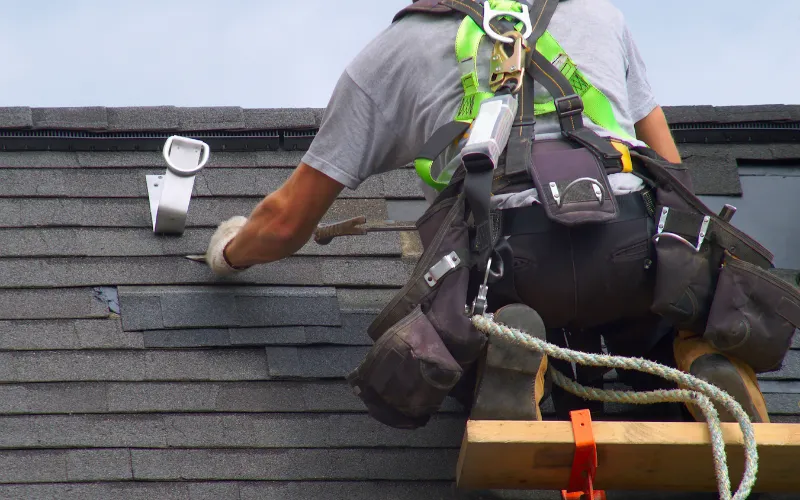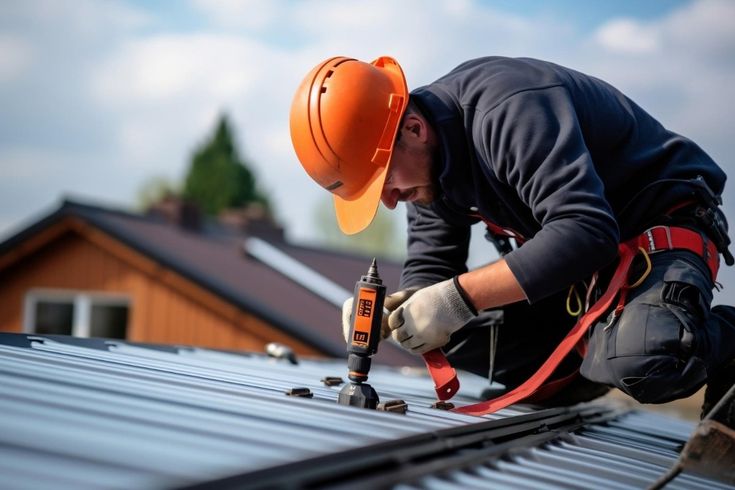
Emergency Roof Patch Repair: How to Stop Leaks Before They Wreck Your Home
Rain’s coming down hard. You hear it before you see it. Drip. Then another. And another. You look up—and there it is. A dark, wet stain spreading across your ceiling. Not good. You grab a bucket, maybe a towel, hoping it’ll stop. But it doesn’t. It just keeps coming. Little by little, that small leak turns into a big problem. Water finds its way into everything—wood, wiring, drywall. It doesn’t stop. Not until you fix it right.
That’s where panic hits. Because finding someone to handle an emergency roof leak isn’t easy. Most contractors are “booked out for weeks.” Others show up late, do a quick patch, and vanish before the next rain. You need someone faster. Smarter. Someone who actually gives a damn about your home.
That’s where Roosevelt Roofing LLC steps in. These guys don’t mess around. When leaks happen, they move. Fast. No waiting days for a callback. No cheap patch jobs that fall apart later. They get on the roof, find the real cause, and fix it like pros. Their crew’s been doing this for years—they know how to stop water dead in its tracks. Real tools, real materials, real results. And yeah, they actually care. That’s rare these days.
People trust them because they show up when others don’t. Because they fix leaks that other roofers couldn’t. And because, when your ceiling’s dripping and your nerves are shot, Roosevelt Roofing LLC makes it right—quick, clean, and built to last.
Key Takeaways
Learn how to perform an emergency roof patch repair quickly and safely.
Understand when a DIY fix works—and when you need a pro roof leak repair service.
Discover products and materials pros use to fix roof leaks fast (even in bad weather).
Get tips for preventing leaks long-term.
Save money by acting early—because waiting? That’s expensive.
Why You Can’t Wait to Patch a Leak
The moment water gets inside your roof, it spreads. Doesn’t stay where it starts. It creeps under shingles, seeps into plywood, finds insulation, even ruins wiring.
And then—you’ve got rot. Mold. Maybe even ceiling collapse. Yeah, it gets that bad.
That’s why an emergency roof patch repair isn’t just “optional.” It’s step one in stopping thousands of dollars in damage.
It’s not a full repair. Not even close. It’s a pause button. Something that buys you time until the weather clears or the roofer shows up.
Think of it like throwing a bucket under the leak. It doesn’t solve it. But it sure stops it from getting worse.

Finding the Leak: It’s Harder Than You Think
People think the leak is right where the ceiling’s wet. Nope. Water travels. Follows rafters, nails, or insulation until it finds a weak spot. That’s where it drips.
Step 1: Check Inside
Go to the attic. Bring a flashlight. Look for dark stains, wet wood, moldy insulation, or shiny nail heads. Sometimes you’ll smell dampness before you see it.
Mark the area with tape or chalk. You’ll need that later when you climb outside.
Step 2: Inspect the Roof
Outside, check these areas first:
Around chimneys and skylights
Near vent pipes and flashing
Under valley joints
Shingles that look lifted, curled, or cracked
Still can’t find it?
Try a “hose test.” Spray sections of the roof one at a time while someone inside watches for drips. Start low, move upward. It’s old-school but works.
Fast Fixes: Emergency Roof Patch Repair Methods That Actually Work
Let’s talk solutions. You need something quick. Strong. Reliable. Something you can do without tearing your whole roof apart.
Tarp It
The classic move.
Use a heavy-duty tarp (12 × 16 ft or bigger). Make sure it covers the leak plus a few extra feet around it. Lay it tight, with the slope of the roof, and secure edges with wood strips and screws.
Don’t nail straight through shingles. You’ll make new leaks.
Seal screw heads with roofing cement. Done right, this buys you days, maybe weeks of safety.
Use Roofing Tape or Membrane
This stuff works wonders on small cracks or flashing gaps.
Clean the area first. Dirt kills adhesion. Cut the tape, stick it down, and smooth it tight. Seal edges with cement or caulk.
Perfect for small leaks when you just need to fix roof leaks fast before the next rain hits.
Roofing Cement
Old-school but reliable. Scoop some with a trowel. Smear it over the crack or hole. Push it in. Smooth it flat. If you’ve got mesh tape, embed it right in the cement for extra strength.
Just don’t go crazy. Thick globs look awful and sometimes trap water. Thin, even coats work best.
Replace a Few Shingles
If the leak’s from a broken or missing shingle, replace it.
Lift the edges of surrounding shingles, pull the nails, and slide a new one in. Nail it down and seal edges.
If you’re nervous on a roof—don’t. Call a roofer. It’s not worth the fall.
Patch Kits
Modern patch kits are amazing. Everything’s pre-mixed and self-contained. You just peel, stick, press, done.
Some even cure underwater (yes, really).
Contractors love these for fast emergency jobs. They’re not cheap, but they work.

When to Call a Roof Leak Repair Service
Let’s be real. DIY is fine for small stuff. But some leaks? They’re monsters.
If you see bubbling paint, sagging drywall, or multiple wet spots—it’s gone beyond patching.
A professional roof leak repair service will:
Find the true source (not just where it drips)
Replace flashing and underlayment if needed
Check decking, vents, and attic moisture
Handle steep or high roofs safely
Document everything for insurance
They also bring better materials—industrial sealants, proper membranes, tools for high adhesion.
And the big one? They guarantee their work.
Permanent Fixes (After the Patch)
Patches are temporary. You’ll need a permanent solution once the rain stops and things dry out. Here’s what that might look like.
Replace Flashing
Flashing failures cause most leaks. Corroded, bent, or loose flashing needs replacement. Use step flashing for slopes, continuous for long edges, and counter flashing for chimneys.
Seal it right. Done once, done right.
Repair the Decking
If water’s been sitting a while, plywood or OSB might be soft or blackened. Replace it. Never patch over rot.
Upgrade Underlayment
Synthetic or ice-and-water shield underlayments are far more durable than old felt paper.
They resist moisture longer and help prevent leaks even if a shingle blows off.
Partial or Full Reroof
Sometimes, your whole roof’s just tired. Over-patched. Cracked. Uneven.
At that point, reroofing saves more in the long run. Especially if shingles are past 20 years old or curling everywhere.
Ventilation Fix
Not all “leaks” are leaks. Poor ventilation causes condensation that looks like one.
Adding ridge vents or soffit vents can prevent mold, moisture, and future “fake leaks.”
Choosing Materials for Your Patch or Repair
Not all sealants or tapes are equal. Some peel off the first hot day. Some outlive the roof itself. Know what’s what.
For Shingle Roofs
Asphalt roofing cement
Butyl rubber sealants
Self-adhesive roofing tape (EPDM or bitumen based)
For Flat or Metal Roofs
EPDM membranes
Silicone sealant
Liquid rubber coatings
Aluminum roof patches
Pro Tip:
Match materials with the weather. Hot states like Nevada? Go UV-resistant. Cold regions? Flexible polymers that won’t crack in frost.
The Cost Reality
Everyone asks it. “How much will it cost to patch my roof?”
Answer: it depends. But let’s give rough ideas.
Small DIY patch (cement + tape): $50–$150
Minor pro patch (1 area): $300–$800
Flashing replacement: $800–$1,500
Partial reroof: $2,000–$4,000
Full reroof: $6,000+
Emergency visits can be extra, especially after storms.
Still, think of it like this: patch now = a few hundred. Wait = thousands.
Preventing Future Leaks
Let’s avoid this whole emergency mess next time.
Inspect Twice a Year
Once in spring. Once before winter. Walk around. Check shingles, flashing, vents, gutters.
Small issues? Fix immediately. Don’t “wait for later.” Later becomes expensive.
Clean Gutters
Overflowing gutters send water right under your shingles. Keep them clean. Install guards if you hate ladders.
Trim Trees
Branches rubbing your roof? That’s sandpaper grinding away granules. Cut them back.
Check Attic Ventilation
If it smells musty or feels damp—something’s wrong.
Balanced ventilation keeps roofs dry and prevents condensation leaks.
Keep Patch Gear Handy
Tarp. Roofing tape. Sealant. Gloves. Ladder.
If storms hit suddenly, you’ll be ready.
Real-World Story Time
The “Chimney Leak” That Wasn’t
A homeowner patched the same ceiling stain three times. Each rain, same spot. Turns out it wasn’t the shingles at all—it was the flashing behind the chimney pulling away.
Once replaced, bone dry.
Moral: Leaks lie.
The Tarp Gone Wrong
Someone stapled a tarp across their roof. Looked fine for a week. Then a windstorm ripped it halfway off, letting in more water than before.
Moral: Don’t half-do it. Secure it right or don’t bother.
The Roofer Who Saved Christmas
Rain. December. Family dinner. Drip-drip in the dining room.
Our crew showed up within an hour, patched it with a fast-cure membrane, and stopped the leak before dinner started. Permanent repair two days later.
That’s the difference a real roof leak repair service makes.
Why Choose Roosevelt Roofing LLC
We’re not just patchers. We’re protectors.
When you call Roosevelt Roofing, you’re getting speed and skill.
Here’s what we bring:
24/7 emergency response — storms don’t punch a clock.
Certified roofers who know every material and method.
Honest pricing. No surprise “extras.”
Fully insured and licensed.
Permanent solutions, not temporary band-aids.
Friendly, real people who answer your call.
We don’t leave until your roof’s dry. Simple as that.
FAQs
Q1: How long will a patch last?
Depends. A good patch can last a few weeks, maybe months. But it’s still temporary. Always schedule a permanent repair.
Q2: Can I do a patch while it’s raining?
You can, but it’s risky. Use a tarp or specialized wet-surface sealant. Stay safe—wet roofs are slippery.
Q3: Will insurance pay for an emergency patch?
Usually, yes, if the damage was sudden (storm, wind, hail). Not for old or neglected roofs. Always take photos and call your insurer early.
Q4: Why do leaks come back after patching?
Because the patch hit the symptom, not the cause. Flashing, underlayment, or structural issues underneath need full repair.
Q5: How fast can you come out for emergencies?
Most times—same day. Roosevelt Roofing LLC responds fast because we know leaks don’t wait.
Conclusion
A leak isn’t the end of the world. But it’s a warning.
Do nothing, it spreads. Act fast, it’s manageable.
An emergency roof patch repair can stop the damage in minutes if done right.
Remember:
Patching buys you time.
Professional repair gives you peace.
Maintenance keeps you safe.
So yeah—patch it now. Then fix it properly.
Call to Action
If your roof’s dripping, don’t panic.
Just call Roosevelt Roofing LLC — your local pros for emergency roof patch repair and lasting fixes.
We’ll show up, seal it, and stop it before it gets ugly.
Contact us today for a free quote and priority scheduling.